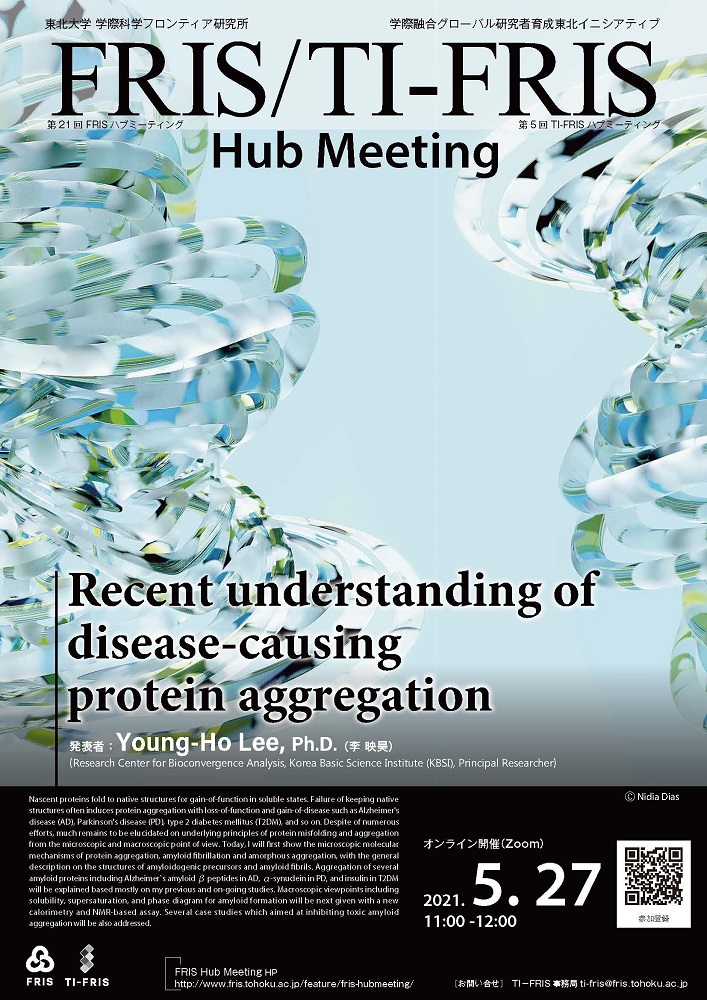May 7, 2021
The 5th TI-FRIS Hub Meeting/21th FRIS Hub Meeting (Online)
TI-FRIS categorizes almost all academic fields into six research fields (Materials and Energy, Life and Environments, Information and Systems, Device and Technology, Human and Society, and Advanced Basic Science). However, TI-FRIS Fellows are not confined to their respective research fields and are actively engaged in exchanges and collaborations with researchers in other research fields, which will allow for the interdisciplinary fusion of a wide range of academic fields and the creation of embryonic research.
The presentations will focus on "what is interesting about my field," "what is the research method in my field," and "introduction of problems that are not likely to be solved only within my field," in addition to the introduction of easy-to-understand research results for researchers in different fields.
The language used is a mixture of Japanese and English. Common sense and way of thinking cannot be expected among researchers in different fields. The audience is encouraged to ask questions during the presentation to discuss and deepen their understandings. Please participate actively.
The 5th TI-FRIS Hub Meeting (jointly held with the 21th FRIS Hub Meeting)
Date and Time:
Event Format:
1Research Center for Bioconvergence Analysis, Korea Basic Science Institute, Korea
2Bio-Analytical Science, Univ. of Science and Technology, Korea
3Research headquarters, Korea Brain Research Institute, Korea
4Graduate School of Analytical Science and Technology, Chungnam National Univ., Korea
Nascent proteins fold to native structures for gain-of-function in soluble states. Failure of keeping native structures often induces protein aggregation with loss-of-function and gain-of-disease such as Alzheimer's disease (AD), Parkinson's disease (PD), type 2 diabetes mellitus (T2DM), and so on.1-3 Despite of numerous efforts, much remains to be elucidated on underlying principles of protein misfolding and aggregation from the microscopic and macroscopic point of view. Today, I will first show the microscopic molecular mechanisms of protein aggregation, amyloid fibrillation and amorphous aggregation, with the general description on the structures of amyloidogenic precursors and amyloid fibrils.4-8 Aggregation of several amyloid proteins including Alzheimer`s amyloid b peptides in AD, a-synuclein in PD, and insulin in T2DM will be explained based mostly on my previous and on-going studies. Macroscopic viewpoints including solubility, supersaturation, and phase diagram for amyloid formation will be next given with a new calorimetry and NMR-based assay.3, 9-18 Several case studies which aimed at inhibiting toxic amyloid aggregation will be also addressed.19
References
[1] Lee et. al. Biochim. Biophys. Acta.- Proteins Proteom. (2019); [2] Terakawa et. al. Biochim. Biophys. Acta.-Biomembr. (2018); [3] Nam and Lin et. al. Chem (2020); [4] Terakawa and Lee et. al. Biochim. Biophys. Acta.-Biomembr. (2018); [5] Lee and Ramamoorthy Protein Sci. (2018); [6] Terakawa and Lee et. al. Biochim. Biophys. Acta.-Biomembr. (2018); [7] Micsonai et. al. Nucleic Acids Res. (2018); [8] Micsonai et. al. Proc. Natl. Acad. Sci. USA. (2015); [9] Kinoshita et. al. Phys. Chem. Chem. Phys. (2017); [10] Terakawa et. al. J. Biol. Chem. (2014); [11] Korshavn et. al. J. Biol. Chem. (2017); [12] Lin et. al. Langmuir (2016); [13] Ikenoue and Lee et. al. Angewandte chemie (2014); [14] Ikenoue and Lee et. al. Proc. Natl. Acad. Sci. USA. (2014); [15] Lin et. al. ACS Nano (2019); [16] Kinoshita and Lin et. al. ChemComm (2018); [17] Park et. al. Proc. Natl. Acad. Sci. USA. (2019); [18] Yi et. al. Chem. Sci. (2021); [19] Kim et. al. Nature Nanotechnol. (2018)


